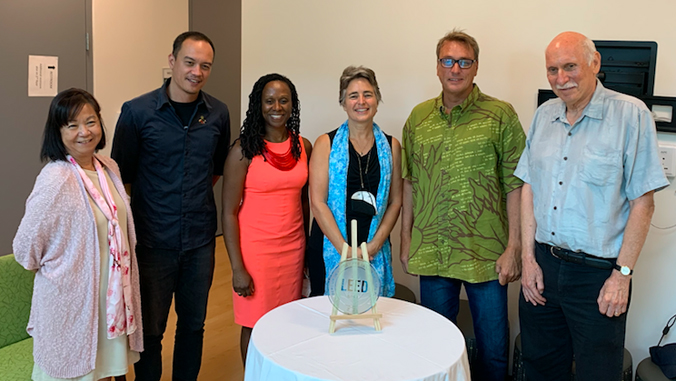UH Law School Building Wins Gold for Sustainability
The University of Hawaii at the Mānoa Clinic Building William S. Richardson School of Law has achieved official Gold Level Leadership in Energy and Environmental Design (LEED) certificate.
In April, Dean Camille Nelson joined former dean Avi Soifer and teacher Denise Antoliniteachers and partners to unveil the official LEED certification plate awarded by the US Green Building Council to the uh Faculty of Law clinic building.

The clinical building incorporates vast LEED features, including on-site photovoltaic solar power (PV) panels, diverting 86% of the project’s construction waste from landfills, and energy reduction measures, such as exterior shading, LED lighting and occupancy sensors, resulting in approximately 31% cost savings. energy. Indoor potable water use has been reduced with low-flow, high-efficiency fixtures, low-water landscaping emphasizes native plants and 48% of building materials. construction used came from the region.
“We focused on choosing sustainability features to minimize the building’s environmental footprint while controlling costs. I’m especially proud that the building makes extensive use of natural lighting, uses non-toxic interior materials that improve occupant air quality, diverts 86% of construction waste from landfill, and has solar panels that generate approximately 14% of the building’s consumption. energy needs,” Antolini said. “We hope the building will inspire others in our community to fight for healthier buildings for people and the planet. The achievement of LEED Gold certification for the clinical building beautifully reflects the core value of sustainability that is part of our mission. uh The Mānoa Campus and Faculty of Law.
The gold rating signifies the extraordinary effort of everyone involved in the planning, design and construction of the clinical building to aim for a high level of sustainability. The Richardson Clinic Building, which was unveiled in 2019, was a combined effort of the uh faculty of Law, uh administrators and the state legislature. The sustainable, state-of-the-art building took more than a decade to come to fruition; it first appeared in 2016.

LEED certified projects must first undergo a verification and review process by Green Business Certification Inc. and be awarded points corresponding to a level of LEED certification, which is a globally recognized symbol of sustainability achievement and leadership.
Nelson said, “This LEED The certification is a testament to the hard work and vision of many people, including former Associate Dean Professor Denise Antolini. With former Dean, Professor Avi Soifer, the University of Hawaii Office of Sustainability and the wonderful architects involved, they envisioned and paved the way for the creation of what is a building that invites experiential learning and community service. They have set a very high standard, a standard that many will follow as we reflect on our built environments and their impact. »
This recognition is an example of uh Mānoa’s goal of building a sustainable and resilient campus environment: as part of the global movement for sustainability and climate resilience (PDF), one of the four objectives defined in the Strategic Plan 2015-2025 (PDF), updated December 2020.


Comments are closed.